Four Chaplains
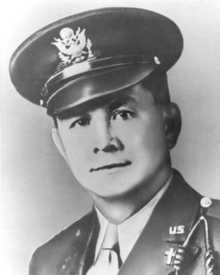

George L. Fox, Alexander D. Goode
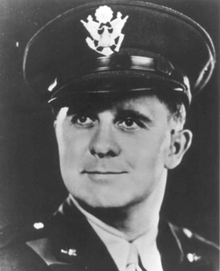

Clark V. Poling, John P. Washington
The Four Chaplains, also sometimes referred to as the "Immortal Chaplains" or the "Dorchester Chaplains", were four United States Army chaplains who gave their lives to save other civilian and military personnel as the troop ship SS Dorchester sank on February 3, 1943, during World War II. They helped other soldiers board lifeboats and gave up their own life jackets when the supply ran out.[1] The chaplains joined arms, said prayers, and sang hymns as they went down with the ship.
The men
The relatively new chaplains all held the rank of first lieutenant. They included Methodist minister the Reverend George L. Fox, Reform Rabbi Alexander D. Goode (Ph.D.), Roman Catholic priest Father John P. Washington, and Reformed Church in America minister the Reverend Clark V. Poling. Their backgrounds, personalities, and denominations were different, although Goode, Poling and Washington had all served as leaders in the Boy Scouts of America.[2] They met at the Army Chaplains School at Harvard University, where they prepared for assignments in the European theater, sailing on board Dorchester to report to their new assignments.
George Lansing Fox
George L. Fox was born March 15, 1900, in Lewistown, Pennsylvania, the eldest of eight children. When he was 17, he left school and lied about his age in order to join the Army to serve in World War I. He joined the ambulance corps in 1917, assigned to Camp Newton D. Baker in Texas. On December 3, 1917, George embarked from Camp Merritt, New Jersey, and boarded the USS Huron en route to France. As a medical corps assistant, he was highly decorated for bravery and was awarded the Silver Star, Purple Heart and the French Croix de Guerre.
Upon his discharge, he returned home to Altoona, where he completed high school. He entered Moody Bible Institute in Illinois in 1923. He and Isadora G. Hurlbut of Vermont were married in 1923, when he began his religious career as an itinerant preacher in the Methodist faith. He later graduated from Illinois Wesleyan University in Bloomington, served as a student pupil in Rye, New Hampshire, and then studied at the Boston University School of Theology, where he was ordained a Methodist minister on June 10, 1934. He served parishes in Thetford, Union Village, and Gilman, Vermont, and was appointed state chaplain and historian for the American Legion in Vermont.
In 1942, Fox volunteered to serve as an Army chaplain, accepting his appointment July 24, 1942. He began active duty on August 8, 1942, the same day his son Wyatt enlisted in the Marine Corps. After Army Chaplains school at Harvard, he reported to the 411th Coast Artillery Battalion at Camp Davis. He was then united with Chaplains Goode, Poling and Washington at Camp Myles Standish in Taunton, Massachusetts, where they prepared to depart for Europe on board the Dorchester.[3]
Alexander David Goode
Reform-Rabbi Alexander D. Goode (Ph.D) was born in Brooklyn, New York on May 10, 1911, the son of Rabbi Hyman Goodekowitz. He was raised in Washington, D.C., attending Eastern High School, eventually deciding to follow his father's footsteps by studying for the rabbinate himself, at Hebrew Union College (HUC), where he graduated with a B.H. degree in 1937. He later received his Ph.D. from Johns Hopkins University in 1940. While studying for the rabbinate at HUC, he worked at the Washington Hebrew Congregation during summer breaks.[4]
He originally applied to become a Navy chaplain in January 1941, but was not accepted. After the attack on Pearl Harbor in 1941, he applied to the Army, receiving his appointment as a chaplain on July 21, 1942. Chaplain Goode went on active duty on August 9, 1942, and was selected for the Chaplains School at Harvard. Chaplain Goode was then assigned to the 333rd Airbase Squadron in Goldsboro, North Carolina. In October 1942, he was transferred to Camp Myles Standish in Taunton, Massachusetts and reunited with chaplains Fox, Poling and Washington, who had been among his classmates at Harvard.[5]
Clark Vandersall Poling
Clark V. Poling was born August 7, 1910, in Columbus, Ohio, the son of evangelical minister Daniel A. Poling, who was rebaptized in 1936 as a Baptist minister. Clark Poling studied at Yale University's Divinity School in New Haven, Connecticut and graduated with his B.D. degree in 1936. He was ordained in the Reformed Church in America, and served first in the First Church of Christ, New London, Connecticut, and then as Pastor of the First Reformed Church, in Schenectady, New York. He married Betty Jung.
With the outbreak of World War II, Poling decided to enter the Army, wanting to face the same danger as others. His father, who had served as a World War I chaplain, told him chaplains risk and give their lives, too—and with that knowledge, he applied to serve as an Army chaplain, accepting an appointment on June 10, 1942 as a chaplain with the 131st Quartermaster Truck Regiment, reporting to Camp Shelby, Hattiesburg, Mississippi, on June 25. Later he reported to Army Chaplains School at Harvard, where he would meet Chaplains Fox, Goode, and Washington.[6]
John Patrick Washington
John P. Washington was born in Newark, New Jersey on July 18, 1908. He studied at Seton Hall, in South Orange, New Jersey, to complete his high school and college courses in preparation for the Catholic priesthood. He graduated in 1931 with an A.B. Degree, entering Immaculate Conception Seminary in Darlington, New Jersey, where he received his minor orders on May 26, 1933. He served as a subdeacon at all the solemn masses and later became a deacon on December 25, 1934. He was elected prefect of his class and was ordained a priest on June 15, 1935.
Father Washington's first parish was at St. Genevieve's, in Elizabeth, New Jersey. He later served at St. Venantius for a year. In 1938, he was assigned to St. Stephen's in Kearny, New Jersey. Shortly after the Pearl Harbor attack of December 7, 1941, he received his appointment as a chaplain in the United States Army, reporting for active duty on May 9, 1942. He was named Chief of the Chaplains Reserve Pool, in Ft. Benjamin Harrison, Indiana, and in June 1942, he was assigned to the 76th Infantry Division in Ft. George Meade, Maryland. In November 1942, he reported to Camp Myles Standish in Taunton, Massachusetts and met Chaplains Fox, Goode and Poling at Chaplains School at Harvard.[7]
The ship
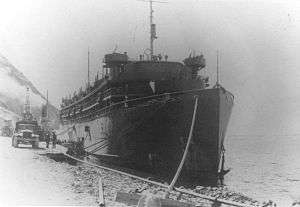
The Dorchester had been a 5,649 ton civilian liner, 368 feet long with a 52-foot beam and a single funnel, originally built in 1926 by Newport News Shipbuilding and Dry Dock Company, for the Merchants and Miners Line, operating ships from Baltimore to Florida, carrying both freight and passengers.[8] It was the third of four liners being built for the Line.
The ship was converted for military service in World War II as a War Shipping Administration troop transport operated by Atlantic, Gulf & West Indies Steamship Lines (Agwilines) allocated to United States Army requirements.[9][10] The conversion was done in New York by the Atlantic, Gulf, and West Indies (AGWI) SS Company, and included additional lifeboats and liferafts; guns (a 3 inch 50 caliber gun forward, and a 4 inch 50 caliber gun aft, in addition to four 20mm guns); and changes to the large windows in the pilot house so that they would be reduced to slits to afford more protection.[11]
Designed for 314 civilian passengers and 90 crew, she was able to carry slightly more than 900 military passengers and crew.
The story
Dorchester left New York on January 23, 1943, en route to Greenland, carrying the four chaplains and approximately 900 others, as part of a convoy of three ships (SG-19 convoy). Most of the military personnel were not told the ship's ultimate destination. The convoy was escorted by Coast Guard Cutters Tampa, Escanaba, and Comanche.[12]

The ship's captain, Hans J. Danielsen, had been alerted that Coast Guard sonar had detected a submarine. Because German U-boats were monitoring sea lanes and had attacked and sunk ships earlier during the war, Captain Danielsen had the ship's crew on a state of high alert even before he received that information, ordering the men to sleep in their clothing and keep their life jackets on. "Many soldiers sleeping deep in the ship's hold disregarded the order because of the engine's heat. Others ignored it because the life jackets were uncomfortable."[13]
During the early morning hours of February 3, 1943, at 12:55 a.m., the vessel was torpedoed by the German submarine U-223 off Newfoundland in the North Atlantic.[13]
The torpedo knocked out the Dorchester's electrical system, leaving the ship dark. Panic set in among the men on board, many of them trapped below decks. The chaplains sought to calm the men and organize an orderly evacuation of the ship, and helped guide wounded men to safety. As life jackets were passed out to the men, the supply ran out before each man had one. The chaplains removed their own life jackets and gave them to others. They helped as many men as they could into lifeboats, and then linked arms and, saying prayers and singing hymns, went down with the ship.[13]
As I swam away from the ship, I looked back. The flares had lighted everything. The bow came up high and she slid under. The last thing I saw, the Four Chaplains were up there praying for the safety of the men. They had done everything they could. I did not see them again. They themselves did not have a chance without their life jackets.— Grady Clark, survivor[14]
According to some reports, survivors could hear different languages mixed in the prayers of the chaplains, including Jewish prayers in Hebrew and Catholic prayers in Latin. Only 230 of the 904 men aboard the ship were rescued. Life jackets offered little protection from hypothermia, which killed most men in the water. The water temperature was 34 °F (1 °C) and the air temperature was 36 °F (2 °C). By the time additional rescue ships arrived, "hundreds of dead bodies were seen floating on the water, kept up by their life jackets."[15]
In film
- The 60-minute TV documentary The Four Chaplains: Sacrifice at Sea was produced in 2004.[16]
- It was announced in 2008 that development of a movie based on the chaplains' story, titled Lifeboat 13, had begun.[17][18] As of January 2013, however, no further information had been released about the project.
In print
- The book Sea of Glory: The Magnificent Story of the Four Chaplains, written by Francis Beauchesne Thornton, was published by Prentice Hall in 1953.[19]
- The book No Greater Glory: The Four Immortal Chaplains and the Sinking of the Dorchester in World War II, written by Dan Kurzman, was published by Random House in 2004.[20]
- Sea of Glory: Based on the True WW II Story of the Four Chaplains and the U.S.A.T. Dorchester, written by Ken Wales and David Poling, is a 2006 book published by B&H Publishing Group. As the title indicates, it is "based on" the story, not an actual factual account.[21]
- The story of the Four Chaplains was also printed in the form of a comic book, "Chaplains at War," The Living Bible #3, March 1946.[22][23]
In music
- A composition entitled "The Light Eternal," written by James Swearingen in 1992, tells the story of the Four Chaplains through music.[24]
In art
In addition to the stained glass windows recalling the chaplains and their heroism, paintings include
- Four Chaplains, 1943, by Alton Tobey[25]
- "A Moment of Peace," Ft. Jackson, South Carolina, painted by Steven Carter.[26]
- The Four Chaplains, Chapel of Four Chaplains.[27]
- "The Four Chaplains," by Art Seidan (the four, pictured at the rail of the ship).[28]
- Four chaplains mural, by artist Connie Burns Watkins, commissioned by the Rotary Club of York, Pennsylvania.[29]
- Four Chaplains mural, painted by Dean Fausett, at entrance to Joseph "Ziggy" Kahn Gymnasium, Jewish Community Center Irene Kaufman Building, Squirrel Hill, Pennsylvania.[30]
- "Four Chaplains mural", painted by Connie Burns Watkins, in York, Pennsylvania.
- Four Chaplains mural, painted by Nils Hogner, at the Chapel of Four Chaplains[31]
- Four Chaplains monument and eternal flame, River view park, Sebastian Florida[32]
Other
- The two-hour audio documentary No Greater Love tells the story, including interviews with survivors, rescuers, and naval historians.[12]
- The 23rd degree conferred by the Ancient Accepted Scottish Rite Northern Masonic Jurisdiction, entitled "Knight of Valor" tells the story of the four chaplains as a lesson of personal sacrifice to aid one's fellow man.[33]
Awards

On December 19, 1944, all four chaplains were posthumously awarded the Purple Heart and the Distinguished Service Cross.[34]
Congress also attempted to confer the Medal of Honor on each of the four chaplains, but the stringent requirements for that medal required heroism performed “under fire,” and the bravery and ultimate sacrifice of these men did not technically qualify, since their actions took place after the torpedo attack. Therefore, members of Congress decided to authorize a special medal intended to have the same weight and importance as the Medal of Honor.[13] This award, the Four Chaplains' Medal, was approved by a unanimous act of Congress on July 14, 1960, through Public law 86-656 of the 86th Congress.[35] The medals were presented posthumously to the next of kin of each of the Four Chaplains by Secretary of the Army Wilber M. Brucker at Ft. Myer, Virginia on January 18, 1961.[36]
In 2006, National Executive Committee of The American Legion, at the Legion’s 88th National Convention in Salt Lake City, passed a resolution urging Congress to revisit the issue of awards, and award the Medal of Honor to Fox, Goode, Poling and Washington.[37]
Remembrance
Four Chaplains Day
In 1988, February 3 was established by a unanimous act of Congress as an annual "Four Chaplains Day."[38] Some state or city officials commemorate the day with official proclamations, sometimes including the order that flags fly at half-mast in memory of the fallen chaplains.[39] In some cases, official proclamations establish observances at other times: for example, North Dakota legislation requests that the Governor issue an annual proclamation establishing the first Sunday in February as "Four Chaplains Sunday."[40]
The day is also observed as a feast day on the liturgical calendar of the Episcopal Church in the United States of America.[41]
U.S. postage stamp
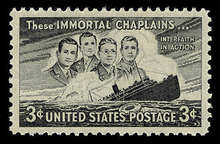
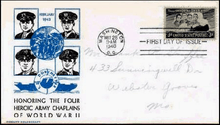
The chaplains were honored with a commemorative stamp that was issued in 1948, and was designed by Louis Schwimmer, the head of the Art Department of the New York branch of the U.S. Post Office Department (now called the USPS).[42] This stamp is highly unusual, because until 2011,[43] U.S. stamps were not normally issued in honor of someone other than a President of the United States until at least ten years after his or her death.[44]
The stamp went through three revisions before the final design was chosen.[45] None of the names of the chaplains were included on the stamp, nor were their faiths (although the faiths had been listed on one of the earlier designs): instead, the words on the stamp were "These Immortal Chaplains...Interfaith in Action."[45] Another phrase included in an earlier design that was not part of the final stamp was "died to save men of all faiths."[45] By the omission of their names, the stamp commemorated the event, rather than the individuals per se, thus obfuscating the ten-year rule in the same way as did later stamps honoring Neil Armstrong in 1969[46] and Buzz Aldrin in 1994.[47]
Chapel of Four Chaplains
The Chapel of the Four Chaplains was dedicated on February 3, 1951, by President Harry S. Truman to honor these chaplains of different faiths in the basement of Grace Baptist Church of Philadelphia. In 1972, that congregation moved to Blue Bell and sold the building to Temple University two years later. Temple University eventually decided to renovate the building as the Temple Performing Arts Center.[48] In February 2001, the Chapel of the Four Chaplains moved to the chapel at the Philadelphia Naval Shipyard.[49]
In his dedication speech, the President said, “This interfaith shrine... will stand through long generations to teach Americans that as men can die heroically as brothers so should they live together in mutual faith and goodwill.”[50]
The Chapel dedication included a reminder that the interfaith team represented by the Four Chaplains was unusual. Although the Chapel was dedicated as an All-Faiths Chapel, no Catholic priest took part in the dedication ceremony, because, as Msgr. Thomas McCarthy of the National Catholic Welfare Conference explained to Time magazine, "canon law forbids joint worship."[51]
In addition to supporting work that exemplifies the idea of Interfaith in Action, recalling the story of the Four Chaplains, the Chapel presents awards to individuals whose work reflects interfaith goals. 1984 was the first time that the award went to a military chaplain team composed of a rabbi, priest, and minister, recalling in a special way the four chaplains themselves, when the Rabbi Louis Parris Hall of Heroes Gold Medallion was presented to Rabbi Arnold Resnicoff; Catholic Priest Fr. George Pucciarelli; and Protestant Minister Danny Wheeler—the three chaplains present at the scene of the 1983 Beirut barracks bombing. The story of these three United States Navy Chaplains was itself memorialized in a Presidential speech (video version) (text version) by President Ronald Reagan, on April 12, 1984.[52]
Memorial foundations
- The Four Chaplains Memorial Foundation, the only 501(c)(3) charity related to the Four Chaplains' legacy, is housed at the former U.S. Naval Chapel located at the former South Philadelphia Navy Yard.[50] Its official mission statement is "to further the cause of 'unity without uniformity' by encouraging goodwill and cooperation among all people. The organization achieves its mission by advocating for and honoring people whose deeds symbolize the legacy of the Four Chaplains aboard the U.S.A.T. Dorchester in 1943."[50] In addition to its other goals and objectives, it supports memorial services that honor the memory of the chaplains and tell their story by publishing Guidelines for Four Chaplains Interfaith Memorial Services.[53] Additionally, it sponsors an "Emergency Chaplains Corps" to provide support for first responders in disaster situations, and scholarship competitions for graduating high school seniors, focusing on the values of "inclusion, cooperation, and unity" exemplified by the Four Chaplains story. The competitions include a National Art Scholarship contest, a National Essay Scholarship contest, and a National Project Lifesaver Scholarship contest.[54]
- The Immortal Chaplains Foundation was incorporated in October 1997 as a Minnesota non-profit corporation. The original concept for the Foundation was from David Fox, nephew of Chaplain George Fox, and Rosalie Goode Fried, the daughter of Chaplain Alexander Goode.[55] The organization's goal is "to honor individuals, both past and present, whose lives exemplify the compassion of the four 'Immortal Chaplains' and who have risked all to protect others of different faith or ethnicity."[55] The group presents an annual "Prize for Humanity," "to broaden national and international awareness of the legacy of the four 'Immortal Chaplains,'" "to inspire youth to the values of the four 'Immortal Chaplains,'" and "to find new partners and ways to tell this story and preserve the legacy."[55] At the 1999 Award Ceremony, held in Minnesota, South African Bishop Desmond Tutu helped present Prizes for Humanity that included posthumous awards for Amy Biehl, an American Stanford University student and Fulbright scholar who was stabbed to death in South Africa while working to establish a Legal Education Center; and Charles W. David, an African-American Coast Guardsman on board the Coast Guard Cutter Comanche, who rescued many of the Dorchester survivors, later dying from pneumonia as a result of his efforts.[56] Unfortunately, the establishment of the Immortal Chaplains Foundation included some controversy, when The Chapel of Four Chaplains sued Fox to prevent him and his new group from using the phrase "The Four Chaplains" or the image of them that appeared on the U.S. postage stamp.[56]
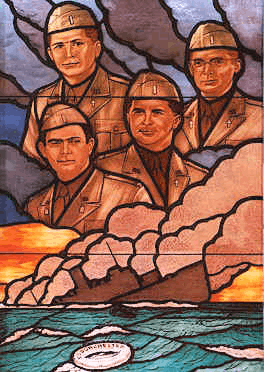
Chapels and sanctuaries
- Immortal Chaplains Memorial Sanctuary - On the Queen Mary in Long Beach, California, and operated by The Immortal Chaplains Foundation. The foundation was founded by the chaplains' families and survivors of the Dorchester tragedy, including 3 survivors of U-boat 223, which sank the Dorchester on February 3, 1943. The Queen Mary transported these men to the USA as POWs one year after the sinking of the Dorchester.[57]
- The chapel at the Pittsburgh International Airport was dedicated to the four chaplains in 1994.[58]
- Joint Base Lewis-McChord, Washington, Four Chaplains' Memorial Chapel & Family Life Center.[59]
- Chapel at Camp Tuckahoe, Boy Scouts of America, in York County, Pennsylvania, dedicated in memory of Chaplain Goode.[60]
Stained glass windows
- United States Pentagon, "A" Ring.[61]
- Fort Jackson, South Carolina, The U.S. Army Chaplain Museum.
- Fort Bliss, Texas, in U.S. Army Sergeant Majors Academy "Four Chaplains Classroom."[61]
- Fort Snelling, Minnesota, Chapel of Immortal Chaplains[39]
- National Cathedral, Washington, D.C, Heroes Chapel Window[61]
- Post Chapel at West Point.[62]
- Memorial Chapel, United States Army War College, Carlisle Barracks, Pennsylvania.[63]
- Basilica of the National Shrine of Mary, Queen of the Universe, Orlando, Florida, North American Saints Window.
- Plymouth Congregational Church, Minneapolis, Minnesota
Sculptures and plaques
- Brotherhood Memorial, Cleveland Cultural Gardens, Rockefeller Park, Cleveland OH. Installed in 1953. Large granite pillar upon which there is a bronze plaque of the Four Chaplains standing in the prow of a large boat with an angelic figure behind and above them. Text memorializes, by name, each chaplain and finishes with "...the unity of this nation founded upon the truth of human brotherhood."[64]
- Four Chaplains Memorial, resembling a flying white bird at the top of the National Memorial Park entrance driveway, Washington, D.C., by abstract expressionist, Constantino Nivola.[65]
- Memorial at Arbor Crest Cemetery, created by sculptor Carlton W. Angell, dedicated to the Four Chaplains in Ann Arbor, Michigan in 1954.[66]
- Memorial plaque at Belmont Park Racecourse in Elmont, New York. It is located behind the clubhouse section of the grandstand. It is bolted onto a rock on the walkway leading to the racing secretary's office.[67][68]
- Memorial plaque in the main lobby (second floor) of the Kings County Courthouse, at 360 Adams Street, Brooklyn, New York.
- Memorial, public park, Dorchester, Wisconsin.[69]
- Memorial plaque ("The Four Chaplains Marker"), Kingwood Memorial Park, Ohio.[70]
- St. Paul's Episcopal Church, Hebron, Maryland: memorials set up both inside and outside of the church.[71][72]
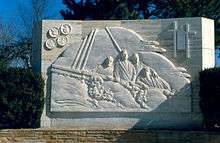
- Plaque, Rhode Island State House, commemorating the Four Chaplains and a Rhode Island native, Walter McHugh, a Coast Guard member who also lost his life on the Dorchester.[73]
- Four Chaplains Memorial, Ft. Wadsworth, Staten Island, New York.[74]
- Four Chaplains Monument, Bottineau, North Dakota.[75][76]
- Memorial, Huntington Park, Newport News, Virginia.[77]
- Memorial plaque, Cedarhurst Park, Cedarhurst, New York
- Memorial sculpture, Washington Park Cemetery, Indiana.[78]
- Wax display at the National Historical Wax Museum (open from 1958 to 1982, now closed) in Washington, D.C.
- Memorial outside American Legion Post 61, Sterling St., Watertown, NY.[79][80]
- Four Chaplains Monument, Timothy Frost United Methodist Church, Thetford Center, Vermont. From 1936 to 1938, Rev. George Lansing Fox served as the pastor of this church and the church in Union Village Vermont.[81]
- Four Chaplains Memorial, outside St. Stephen's Church, Kearny, NJ. St. Stephen's was Father Washington's last assignment before he joined the Army. On the 70th Anniversary of the sinking of the Dorchester, this statue was dedicated. The front shows the four men, arms locked, praying on the stern of the Dorchester, and the back is an angel, carrying four lifejackets for the men.[82]
- Memorial at Olathe Veterans Memorial Park, in Olathe, Kansas.[83]
- Plaque, elevator lobby second floor, Raymond G Murphy VA Medical Center, Albuquerque, NM
- Plaque dedicated to the Four Immortal Chaplains, at the entrance to the Albany, New York War Memorial.[84]
- "SS Dorchester" plaque, front lobby, Utica Memorial Auditorium, Utica, NY.
Miscellaneous remembrances
- The Four Chaplains Memorial Viaduct, carrying Ohio State Route 172 over the Tuscarawas River in Massillon, Ohio, was built in 1949 and refurbished in 1993. It is part of the old Lincoln Highway. A memorial plaque can be found on the eastern end.[85]
- "Field of the Four Chaplains" at Fort Benning, Georgia.[86]
- The 23rd Degree of the Ancient Accepted Scottish Rite of Freemasonry (Northern Jurisdiction) is based on the Four Chaplains incident, teaching "that faith in God will find expression in love for our fellow man, even to the ultimate personal sacrifice".[87]
- Alexander D. Goode Elementary School in York, Pennsylvania. Students honor the four Chaplains annually.[88]
- Four Chaplains Memorial Swimming Pool, Veterans Hospital, Bronx, New York.[89]
- Knights of Columbus Council #13901, located at Fort Leonard Wood is known as the "Four Chaplains Council".[90]
Ceremonies and services
Ceremonies and services are held each year on or around the Feb 3 "Four Chaplains Day" by numerous military and civilian groups and organizations. Civitan International, a worldwide volunteer association of service clubs, holds an interfaith Clergy Appreciation Week every year. The event honors the sacrifice of the Four Chaplains by encouraging citizens to thank the clergy that serve their communities.[91] The First Parish Church (Unitarian Universalist) in Dorchester, Massachusetts, hosts an ecumenical "Service of the Four Chaplains" each January.[92] The American Legion commemorates the day through services and programs at many posts throughout the nation.[37]
On February 14, 2002, as part of the annual award of the Immortal Chaplains Prize for Humanity, a special reconciliation meeting took place between survivors of both the American and German sides of the sinking of the Dorchester. Kurt Röser and Gerhard Buske, who had been part of the crew of the German U-boat that had torpedoed the Dorchester met with three Dorchester survivors, Ben Epstein, Walter Miller, and David Labadie, as well as Dick Swanson, who had been on board the Coast Guard Cutter Comanche, escorting the Dorchester's convoy.[93][94]
On February 3, 2011, the Library of Congress Veterans History Project and the United States Navy Memorial co-hosted a special program at the Memorial, in Washington, D.C.[95]
The Jewish Chaplains Monument at Arlington National Cemetery's Chaplains' Hill was dedicated on October 24, 2011. The monument honors 14 Jewish chaplains who died during their military service. The monument is a granite upright with a bronze plaque, similar to the three other monuments at the site honoring Catholic, Protestant and World War I chaplains. Rabbi Goode's name is the first listed on the plaque. The Jewish Chaplains Monument was approved by the United States Congress in May 2011, and the monument itself, designed by Debora Jackson of Long Island, New York, was reviewed and approved by the U.S. Fine Arts Commission on June 16, 2011. The dedication ceremony was held in Arlington's Memorial Amphitheater. The ceremony was attended by Ernie Heaton, who survived the Dorchester sinking, and Richard Swanson who was on the Coast Guard rescue team.
See also
- Chaplain Corps (United States Army)
- Cecil Pugh — a South African chaplain in the Royal Air Force who gave his life in similar circumstances in 1941
References
- ↑ Eastwood, John H. (1995). "17: A Personal Testimony". The Wonder of Grace. Companion Press. pp. 123–124. ISBN 1-56043-572-0.
- ↑ Larson, Keith. "The Immortal Chaplains". Scouts on Stamps Society International. Retrieved 2009-02-03.
- ↑ "Fox bio page". Fourchaplains.org. Retrieved 2013-01-19.
- ↑ Chaplain Alexander Goode (1911–1943): Gave His Life for the Highest Duty, Student and Teacher Resources, Jewish Historical Society of Greater Washington, 2007.
- ↑ "Goode bio page". Fourchaplains.org. Retrieved 2013-01-19.
- ↑ "Poling bio page". Fourchaplains.org. Retrieved 2013-01-19.
- ↑ "Washington bio page". Fourchaplains.org. Retrieved 2013-01-19.
- ↑ "The ship sank, but heroism survived Faith: Four chaplains gave away their life preservers and stood together, praying, as the Dorchester went down.". tribunedigital-baltimoresun.
- ↑ Maritime Administration. "Dorchester". Ship History Database Vessel Status Card. U.S. Department of Transportation, Maritime Administration. Retrieved 18 April 2015.
- ↑ Grover, David (1987). U.S. Army Ships and Watercraft of World War II. Naval Institute Press. pp. 17, 20, 61. ISBN 0-87021-766-6. LCCN 87015514.
- ↑ GreatShips.com, retrieved February 6, 2011
- 1 2 "AmericanVeteransCenter.org". AmericanVeteransCenter.org. 1943-01-23. Retrieved 2013-01-19.
- 1 2 3 4 The Four Chaplains Memorial Foundation. The Saga of the Four Chaplains. Accessed 2010.02.03.
- ↑ Kvaran, Einar Einarsson, An Annotated Inventory of Outdoor Sculpture of Washtenaw County, unpublished document, 1989
- ↑ Morison, Samuel Eliot (1975). History of United States Naval Operations in World War II, Volume I The Battle of the Atlantic 1939-1943. Little, Brown and Company.
- ↑ chasmilt777 (10 November 2004). "The Four Chaplains: Sacrifice at Sea (TV Movie 2004)". IMDb.
- ↑ MonstersAndCritics.com Accessed February 4, 2011.
- ↑ McNary, Dave (2008-04-20). "''Variety'' magazine". Variety.com. Retrieved 2013-01-19.
- ↑ LCCN 52-10662 OCLC 1349281
- ↑ ISBN 978-0375508776 OCLC 53019525
- ↑ Books.google.com. Books.google.com. Retrieved 2013-01-19.
- ↑ Image of comic book story of the Four Chaplains., retrieved February 5, 2011.
- ↑ Cover Image, comic book version of story, retrieved February 5, 2011.
- ↑ Lee Salisbury. "Recognition received from the Four Chaplains Memorial Foundation for having composed The Light Eternal". Jamesswearingen.com. Retrieved 2013-01-19.
- ↑ Alton Tobey website, retrieved February 5, 2011.
- ↑ Tulsaworld article, retrieved February 5, 2011.
- ↑ Flikr.com, retrieved February 5, 2011.
- ↑ HomeOfHeroes.com, retrieved February 5, 2011.
- ↑ The Rotarian, retrieved February 5, 2011.
- ↑ Pittsburgh Post-Gazette article, retrieved February 5, 2011.
- ↑ The Chapel of the Four Chaplains Fact Sheet
- ↑ "Sebastian to unveil monument honoring WWII's "The Four Chaplains" - VeroNews: Sebastian Spotlight". Veronews.com. May 25, 2012. Retrieved October 19, 2015.
- ↑ "Freemasons For Dummies: The Four Chaplains".
- ↑ "Story". FourChaplains.org.
- ↑ "No Greater Love". Archived from the original on 2011-07-17. Retrieved 2014-02-03.
- ↑ "Federal Military Medals and Decorations". Foxfall Medals.
- 1 2 Legion.org, Accessed February 5, 2011.
- ↑ Rees, Lloyd, WorldNetDaily.com, accessed February 4, 2011.
- 1 2 JordanNews.com, accessed February 4, 2011.
- ↑ North Dakota official holiday guidelines, retrieved February 6, 2011.
- ↑ Communio.stblogs.org, accessed February 4, 2011.
- ↑ StampCenter.com, "A sweet tribute to Four Chaplains on a Postage Stamp," Pt III of III, retrieved February 6, 2011.
- ↑ "Citizens' Stamp Advisory Committee". USPS. September 2011. Retrieved 2011-09-29.
- ↑ "Four Chaplains Stamp - The story of the original first design by Louis Schwimmer".
- 1 2 3 StampCenter.com, "A sweet tribute to Four Chaplains on a postage stamp, part II of III", retrieved February 6, 2011.
- ↑ "First Man on the Moon" 10₵ United States Air Mail stamp
- ↑ "First Moon Landing, 1969" 29¢ United States postage stamp, based on a photograph of Aldrin captured by Neil Armstrong on July 20, 1969 (July 21, UTC). Aldrin, conversely, captured no photographs of Armstrong.
- ↑ "Baptist Temple: New life on North Broad". Temple University News Center. Temple University. 12 September 2007. Retrieved 29 March 2015.
- ↑ "About the Chapel". Four Chaplains Memorial Foundation. Retrieved 29 March 2015.
- 1 2 3 "FourChaplains.org". FourChaplains.org. 1951-02-03. Retrieved 2013-01-19.
- ↑ Time Magazine article from February 12, 1951, retrieved February 5, 2011.
- ↑ "U.S. Presidency records, retrieved March 9, 2012". Presidency.ucsb.edu. 1984-04-13. Retrieved 2013-01-19.
- ↑ http://www.fourchaplains.org/ServiceGuide.pdf
- ↑ Programs page, Four Chaplains website, retrieved February 5, 2011.
- 1 2 3 "ImmortalChaplains.org". ImmortalChaplains.org. Retrieved 2013-01-19.
- 1 2 Congressional Record, February 9, 1999, pg. E176, quoting February 7, 1999, article from "Pioneer Press", retrieved February 7, 2011.
- ↑ "A new Interfaith Memorial Sanctuary on the Queen Mary will include a diorama depicting the final moments of the four Immortal Chaplains and the 670 men who died with them". Immortalchaplains.org.
- ↑ Oregon.gov, Cultural Heritage Courier, Summer 2010 (Noting remembrances of Four Chaplains because Daniel Poling, son of Chaplain Clark Poling, attended Dallas College, Oregon), Accessed February 5, 2011.
- ↑ "Chapels". US Army.
- ↑ New Birth of Freedom Council, Boy Scouts of America, Accessed February 5, 2011.
- 1 2 3 NewsSun.com, Accessed February 5, 2011.
- ↑ Office of the USMA Chaplain. Click on "Chapels" in left-hand column and then click on "Post Chapel", for the chapel's history and photo. USMA official website. Retrieved 2009-12-23.
- ↑ Carlisle Barracks website, retrieved February 5, 2011.
- ↑ Lederer, Clara (1954). "In The True Spirit". Their Paths are Peace: The Story of Cleveland's Cultural Gardens. Cleveland Cultural Garden Federatio. pp. 24–25. Retrieved February 3, 2012.
- ↑ TheDCTraveler.com, accessed February 4, 2011.
- ↑ Ann Arbor Crest Cemetery, retrieved February 5, 2011.
- ↑ BelmontStakes.com, Accessed February 5, 2011.
- ↑ Belmont Memorial image on Flikr.com, retrieved February 5, 2011.
- ↑ "S.S. Dorchester Memorial Marker". Hmdb.org. Retrieved 2013-01-19.
- ↑ "HMDB.org". HMDB.org. Retrieved 2013-01-19.
- ↑ Wicomico Composite Squadron(Record of participation in service at site of memorial), Accessed February 5, 2011.
- ↑ "The Four Immortal Chaplains Marker". The Historical Marker database. Retrieved 29 March 2015.
- ↑ http://www.omsa.org/files/jomsa_arch/Splits/2014/438234_JOMSA_Vol65_5_28.pdf
- ↑ Photo page for Fort Wadswoth, retrieved February 5, 2011.
- ↑ North Dakota Tourism site, retrieved February 5, 2011.
- ↑ Image on RoadsideAmerica.com, retrieved February 5, 2011.
- ↑ Photos of Huntington Park Memorial, retrieved February 5, 2011.
- ↑ Image of sculpture at Washington Park Cemetery, on flikr.com, retrieved February 5, 2011.
- ↑ Image and description of American Legion Memorial on 10th Mountain Vet Page, retrieved February 5, 2011.
- ↑ Close-up photo of American Legion Post 61 Memorial to Four Chaplains, retrieved February 5, 2011.
- ↑ "4 Chaplains Monument".
- ↑ "70th Anniversay Mass, at Church of St. Stephen in Kearny". The Star-Ledger - NJ.com.
- ↑ "Olathe Veterans Memorial Park - Olathe, Kansas".
- ↑ "The Four Immortal Chaplains Marker". The Historical Marker database. Retrieved 29 March 2015.
- ↑ Brown, Gary (February 4, 2012). "Postcard from Massillon: Honoring Four Chaplains". The Repository. Retrieved February 4, 2013.
- ↑ "Presbyterian Church (U.S.A.) - News & Announcements". Pcusa.org. 2013-01-15. Retrieved 2013-01-19.
- ↑ Ancient Accepted Scottish Rite (See explanation of 23 degree "Chief of the Tabernacle" rite.
- ↑ "Goode K-8 - York City School District". Ycs.k12.pa.us. Retrieved 2013-01-19.
- ↑ TrumanLibrary.org, accessed February 4, 2011.
- ↑ "Home". Flwkofc.org. Retrieved 2014-02-03.
- ↑ "Clergy Appreciation Week". Civitan International website. Retrieved 2008-05-27.
- ↑ "First Parish Church Dorchester". Firstparishdorchester.org. Retrieved 2013-01-19.
- ↑ Reconciliation page, ImmortalChaplains.org, accessed February 5, 2011.
- ↑ Gourevitch, Philip, "Former Enemies Meet in Memory of Four Martyrs," "The New Yorker," February 21 and 28, 2002.
- ↑ WashingtonExaminer.com, accessed February 4, 2011.
External links
| Wikimedia Commons has media related to Four Chaplains. |
- Educational video on the Four Chaplains
- Official military report of Dorchester's sinking
- Slide presentation, USAT Dorchester
- "No Greater Sacrifice: Dorchester's Four Chaplains, TheFreeLibrary.com.
- Sassaman, Richard, "The Faithful Four", article in "America in WWII," February, 2008.
- Audio recording of the Four Chaplains story, The American Storyteller Radio Journal
- The Four Chaplains Memorial Foundation
- The Immortal Chaplains Foundation
- Chapel of Four Chaplains (at Find A Grave)
- U.S.A.T. Dorchester Files
- The Story of the Four Chaplains Postage Stamp
- Scouts on Stamps Society International: The Immortal Chaplains
- "Four Chaplains". "Speaking of Faith" Memorial Day. NPR. (five NPR clips, including: "History of the USAT Dorchester"; "Audio Clip of Rabbi [Goode's] Wife"; "Audio Clip of Survivors"; and "Speech by Archbishop Desmond Tutu" excerpted from his speech at The Immortal Chaplains Foundation's 1999 Prize for Humanity ceremony)
- FAU.edu
- HomeOfHeroes.com
- Four Immortal Chaplains who Died to Save Men of All Faiths
- Illinois Wesleyan grad one of immortalized 'Four Chaplains' - Pantagraph (Bloomington, Illinois newspaper)